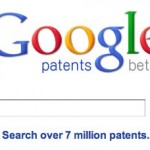(NOTE: At the end of this post is a detailed spreadsheet that lists the free and low cost tools that I use regularly in my IP strategy practice. At the request of a group of IP strategy professionals with whom I network, I will be giving a presentation on these tools at a local event. I thought that readers of this blog would also appreciate learning about how these tools can add high value at a low to minimal cost.)
 In private conversations, some of my corporate peers inform me that they pay $1000's per year (or even per quarter for larger companies) for access to "name brand" patent search tools that nonetheless do not contain accurate and up to date information. For example, a client tells me that one of these expensive tools fails to update USPTO records on
In private conversations, some of my corporate peers inform me that they pay $1000's per year (or even per quarter for larger companies) for access to "name brand" patent search tools that nonetheless do not contain accurate and up to date information. For example, a client tells me that one of these expensive tools fails to update USPTO records on
Free and Low Cost Patent Search and Analysis Tools: Who Needs Expensive Name Brand Products?
Enhancing Innovation ROI by Adding Patents at the Front End: Some Resources
 A new client has asked for some information on how consideration patents and IP at the front end of the innovation/product development process can enhance business value. Readers of this blog might find this material informative, also.
This is a published article from Innovation Management article entitled "How to Improve Innovation ROI with Early Stage Patent Expertise." In this article, I discuss how IP can help orient innovation teams in a direction that can enhance value capture. Practical steps to implement such a program into innovation processes is included in this article.
Here is a YouTube video that explains my process simply. In short, including IP at the front end of a company's innovation process allows one to enhance their calibration with respect to the IP rights of others to better ensure that they will achieve the desired ROI on
A new client has asked for some information on how consideration patents and IP at the front end of the innovation/product development process can enhance business value. Readers of this blog might find this material informative, also.
This is a published article from Innovation Management article entitled "How to Improve Innovation ROI with Early Stage Patent Expertise." In this article, I discuss how IP can help orient innovation teams in a direction that can enhance value capture. Practical steps to implement such a program into innovation processes is included in this article.
Here is a YouTube video that explains my process simply. In short, including IP at the front end of a company's innovation process allows one to enhance their calibration with respect to the IP rights of others to better ensure that they will achieve the desired ROI on
The Apple vs. Samsung Verdict Actually Demonstrates that Patents Do Promote Product Innovation
In the time that the Apple vs. Samsung patent fight has been underway, we have been inundated with an untold number of articles on how Apple is stifling innovation in the SmartPhone world. (Haven't seen these: just do a Google search for "Apple stif . . ." you don't have to type any more than this--the search auto-completes itself.) I often take a contrarian view from that stated by most "expert" commentators--be they members of the press or actual patent professionals, and the Apple v. Samsung verdict is no exception: I think the result actually demonstrates that the patent system is working just fine in this instance, thank you very much. But how can this be when Samsung got hit with more than a BILLION US DOLLAR jury verdict last week?!? Doesn't the fact that Samsung could not make a product without infringing Apple's multitude of patents mean that
Google Changes the Game Again–This Time for Patent Owners and Those Who Serve Them
 Patrick Anderson of the great Gametime IP blog reported the details of Google's new prior art searching tool*. This is such important news, I thought it important to repeat it in a separate post. Patrick provides detailed instructions for how to use the Google patent searching tool, and I will not repeat that information here. This post provides commentary on why I think this is a very good development for the patent world. Google's original announcement on its blog is here. It does not appear coincidental that Google is upgrading its patent searching capabilities: in this press release from June 2010 we are informed of the partnership between Google and the USPTO to increase the amount of US patent information available to the public.
When used correctly, Google's tool can help "democratize" the patent analysis process
Patrick Anderson of the great Gametime IP blog reported the details of Google's new prior art searching tool*. This is such important news, I thought it important to repeat it in a separate post. Patrick provides detailed instructions for how to use the Google patent searching tool, and I will not repeat that information here. This post provides commentary on why I think this is a very good development for the patent world. Google's original announcement on its blog is here. It does not appear coincidental that Google is upgrading its patent searching capabilities: in this press release from June 2010 we are informed of the partnership between Google and the USPTO to increase the amount of US patent information available to the public.
When used correctly, Google's tool can help "democratize" the patent analysis process
Companies Adopting Open Innovation Must Incorporate Patent Information at the Front End
(Editorial note: This is a repost from this blog over 2 years ago, but the content is more relevant than ever. On January 20, 2010, I am participating in a Yet2.com webinar with Ben DuPont and Jason Lye where we will be sharing our thoughts about marketing technology to "non-traditional" technology buyers, many of whom come to the table because they are adopting Open Innovation into their product and technology development processes. I thought this "classic" post would be a good overview for anyone of my viewpoint for those who find my blog as a result of this event. For regular readers, well, I hope you enjoy this too. I will post a link to the recorded webinar when it is available. ) Open Innovation is unquestionably becoming a “hot” area of focus for U.S. companies, especially in the current economic climate in which businesses are more
My Gift to You: Free (or almost free) Patent Searching and Analysis Tools
Happy Holidays everyone! I woke up this morning to the Christmas sunrise over Miami Beach on Christmas morning. Having grown up in this town--where Christmas means a trip to the beach, not the joy of new ice skates--I am feeling a whole lot of holiday spirit. This made me realize that I have been meaning to respond to some inquiries folks have made about patent searching tools that I use in my daily IP Strategy work. Since most of these are free (or almost) free, consider this your holiday gift from me! I hear it now: "Free? Did she say free? But, such and such company wants to charge me $1500 a month, which is a much better deal than my lawyers charge me for monitoring patents in my business space on an ongoing basis. And, this consultant offered to do a whitespace analysis that would solve all my innovation
How Patent Whitespace Analysis Can Set a Company Up for Sustainable Failure
I spent a few days last week at the Innovation Cubed Conference in Orlando. While there, I heard two instances of use of a term that I absolutely hate, at least when it is used by innovation professionals to define in some manner the innovation processes of their respective organizations. This word is:
PATENT WHITESPACE ANALYSIS
Not only do I hate this phrase, I think that companies that utilize patent (or IP) whitespace analysis to define their product and technology development pathways are quite possibly setting themselves up for failure. And, it's bad enough that a single innovation project might fail as a result of the faulty data inputs that can occur from relying on whitespace assessments, but I think that most corporate processes incorporating patent whitespace analysis are based upon faulty methodology, thus setting the organization up for sustainable failure. For the uninitiated, when applied to the patent world,Patent Information is a Necessary Calibration Tool: How the Pilgrims’ Journey is a Metaphor for the Innovation Process
Regular readers of this blog will recognize that I am a strong advocate of the use of patent information in the front end of innovation processes. (More on this here, here and here.) Relatively few innovation professionals actually do so, however, likely because it can be difficult for innovators to understand how to change the longstanding paradigm where lawyers are perceived to be the people who "put the 'no' in innovation." Put simply, I find that innovation professionals prefer to leave anything smelling of legal advice out of the front end of their processes because they think they will not be able to do their jobs if the lawyers show up to their meetings. Of course, it makes little sense for innovation professionals to make significant business decisions involving new products or technology without also knowing whether they will be able to own the fruits of their innovations
Jackie Hutter Speaking at the Minneapolis May LES Meeting
I love meeting my online friends and collaborators IRL ("in real life"). If any of you are located in the Minneapolis area, please consider attending May 11, 2010 LES meeting where I will speak on collection and analysis of patent data. I am being sponsored by this event by my client Clyde Hanson of Venture Isles. Here is the information as circulated by Mr. Hanson: You are welcomed to attend the luncheon even if you are not a member. Ms. Hutter is an advisor to Venture Isles and we have worked together on many projects. She is a self-described “recovering patent attorney”, a prolific blogger and a sharp intellect so it will be a high-energy event. The food is by D’Amico has been consistently good. Save room for dessert. Please register at: LES USA/CANADA How to Properly Collect, Analyze
Start-up Entrepreneurs & CEO’s: If Your Goal is Investment or Acquisition, You are Probably Patenting the Wrong Things
Do you treat your patents as a fence or a tollbooth? If you wish for your start-up technology company to obtain investment from or acquisition by a bigger player, you had better understand the difference. Most start-up technology company entrepreneurs and CEO's understand that patents can be key to establishing the value of a new business idea. Typically, entrepreneurs and CEO's such as yourself will engage patent attorneys to build an IP portfolio that protects the start-up's technology and products to the fullest extent possible. The motivation for this effort and expense is, of course, to to protect your start-up's idea from use by others. As management of a start-up you may be seeking to build an ongoing business around the patented technology, but often the goal of building a solid patent portfolio is to make your business an attractive target for investment or acquisition by a larger company. I believe that


